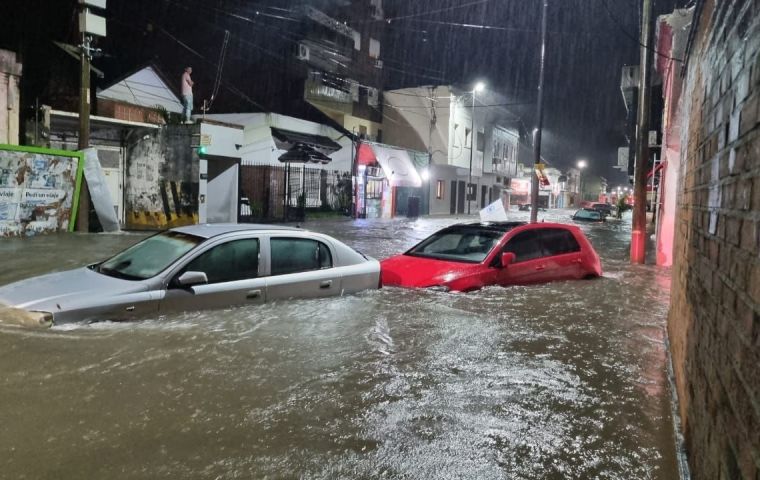MercoPress. South Atlantic News Agency
Corrientes and Montevideo under water due to heavy rains
 Cars sank into the temporary water flows throughout the provincial capital
Cars sank into the temporary water flows throughout the provincial capital The city of Corrientes, the capital of the Argentine province of the same name, was left under water Sunday as 209 millimeters of heavy rains caused floods and material damage while vehicles were swept away by the current. Classes were suspended for Monday amid widespread power outages, with streets turned into temporary rivers.
Relief teams were deployed as City Hall authorities urged the population to follow the safety indications and avoid unnecessary displacements as victims were evacuated. The province is under an orange storm alert issued by the National Meteorological Service (SMN).
“It is the worst natural catastrophe since official records exist,” Corrientes City Undersecretary of Risks and Catastrophes José Pedro Ruiz said. “We are working intensively with all the equipment at the disposal of the citizens. We started with the most complicated areas, but we are going to be all over the city. The teams will be working for the next 48 hours,” he also explained. “Unfortunately there were floods and very damaged sectors because the reality is what we always say: the city's drains are not enough to cope with such intense phenomena, no matter how unblocked and clean they are. It is like unloading a 500-liter tank in a kitchen sink at once, it will clearly collapse.”
The storm also caused “El Gran Mural,” an artwork engraved on one of the external walls of the Convent of San Francisco, 70 meters long and 3.5 meters high, to collapse. The mural evokes the life of the aboriginal Guarani from the arrival of the conquistadors to the 20th century.
According to the newspaper Época, by 5 am Sunday the rain gauge of the Corrientes Institute of Water and Environment had recorded 190 millimeters when the city's drainage can withstand only 50.
Montevideo
Also hit by heavy rains this weekend was Montevideo, which prompted criticism from Uruguay's ruling Multicolor Coalition since the opposition Broad Front (Frente Amplio - FA) is at the helm of the country's capital. Mayor Carolina Cosse is on leave to focus on her presidential bid.
Acting Mayor Mauricio Zunino explained that “in 30 minutes it rained 60 millimeters” which generated “the overflows” in the streets. In his opinion, the “drainage system worked well,” because “it was clean” and allowed “the water to go down quickly,” so “the situation was controlled properly,” he added.
“Montevideo has suffered this type of climatic phenomena in recent times very frequently, and it is part of what we have to think about to see how we react, in a new phenomenon that has to do with climatic alterations,” he also pointed out.




Top Comments
Disclaimer & comment rulesCommenting for this story is now closed.
If you have a Facebook account, become a fan and comment on our Facebook Page!